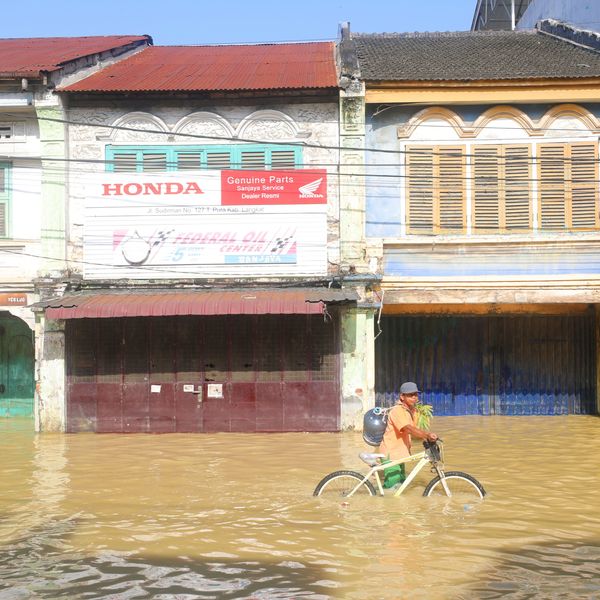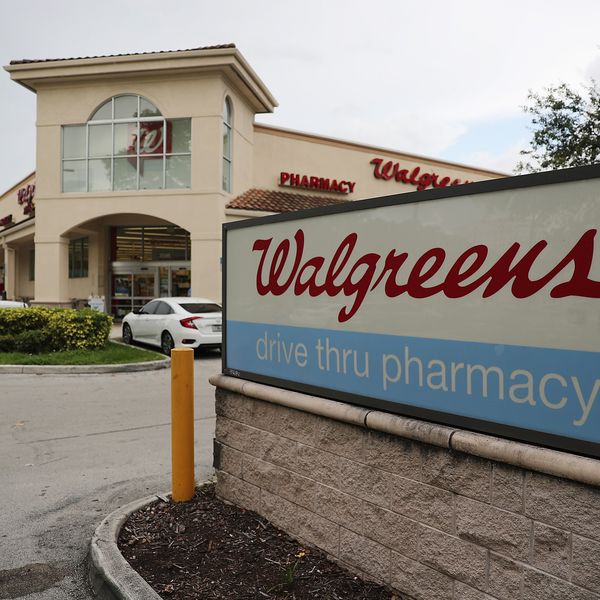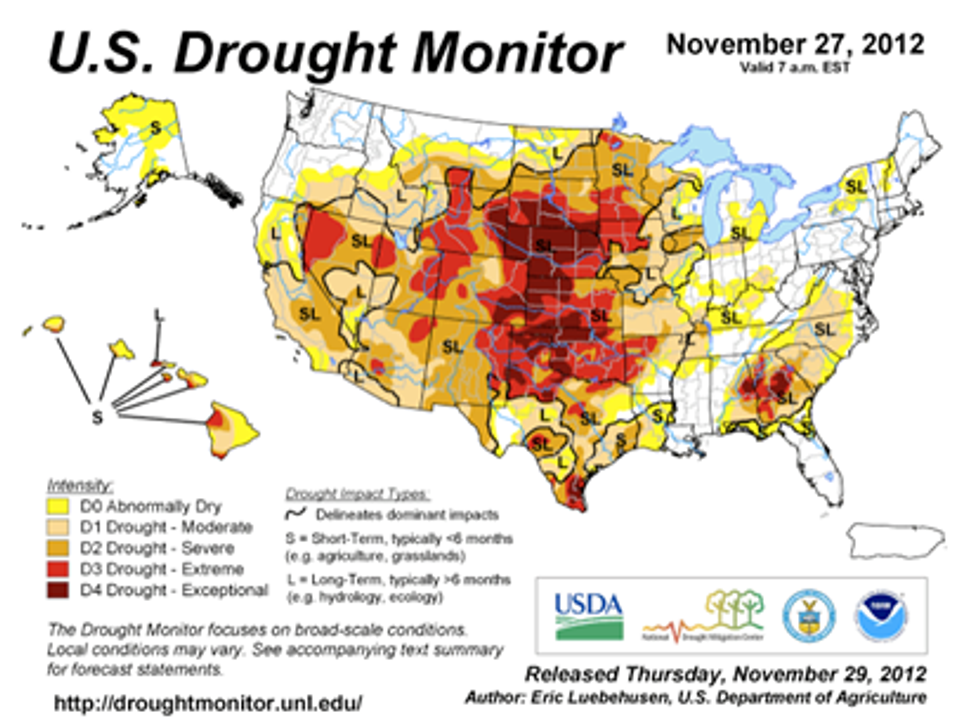Extreme Drought Continues, Could be Most Extreme Weather Event This Year
It's been overshadowed by other extreme weather events recently, but the extreme drought that plagued the U.S. this summer continues. In fact, according to the Drought Monitor, conditions have worsened slightly across the country. The extreme drought is likely to extend through February and could be the most extreme weather event in the U.S. this year, which is saying a lot in a year that saw a superstorm flood large swaths of New York City and knock out power to millions of people.
Beyond the millions of dollars in lost agricultural yield, the extreme drought threatens the Ogallala Aquifer, the single most important water source in the High Plains regions. A commentator on Climate Progress pointed out that the areas that are suffering from the most severe drought overlap with the Aquifer. As shown below, the overlap is substantial.
This means that the groundwater supply for large swaths of Nebraska, Kansas, and Texas are at risk. But, extreme drought isn't the only thing that is threatening the Ogallala. As we pointed out earlier, if the Keystone XL pipeline is built, it will cross the Aquifer and based on past performance, an oil spill is all but guaranteed in the area. The threat of pipeline spills poisoning the water supply is so great that the Republican governor of Nebraska wrote to the Obama Administration to ask them to deny the pipeline's permit.
While the full pipeline permit was denied earlier this year, the Administration backed building the southern portion of the pipeline and construction began on it in August. Given that the northern section is already built--and has already spilled 20,000 gallons of oil-- it's obvious that construction on the southern portion virtually guarantees that the full pipeline will be built.
This move does nothing to bring us closer to energy independence and sets us far back in the fight against climate change. There is no guarantee that any oil brought down through the pipeline will stay in the U.S. Plus, tar sands mining is notoriously destructive and ramping up oil production does nothing to bring us closer to a new energy future.
The threat of spills from the pipeline, combined with the continued extreme drought, does not bode well for the future of the Ogallala or the future of groundwater supplies for millions of people.
An Urgent Message From Our Co-Founder
Dear Common Dreams reader, The U.S. is on a fast track to authoritarianism like nothing I've ever seen. Meanwhile, corporate news outlets are utterly capitulating to Trump, twisting their coverage to avoid drawing his ire while lining up to stuff cash in his pockets. That's why I believe that Common Dreams is doing the best and most consequential reporting that we've ever done. Our small but mighty team is a progressive reporting powerhouse, covering the news every day that the corporate media never will. Our mission has always been simple: To inform. To inspire. And to ignite change for the common good. Now here's the key piece that I want all our readers to understand: None of this would be possible without your financial support. That's not just some fundraising cliche. It's the absolute and literal truth. We don't accept corporate advertising and never will. We don't have a paywall because we don't think people should be blocked from critical news based on their ability to pay. Everything we do is funded by the donations of readers like you. Will you donate now to help power the nonprofit, independent reporting of Common Dreams? Thank you for being a vital member of our community. Together, we can keep independent journalism alive when it’s needed most. - Craig Brown, Co-founder |
It's been overshadowed by other extreme weather events recently, but the extreme drought that plagued the U.S. this summer continues. In fact, according to the Drought Monitor, conditions have worsened slightly across the country. The extreme drought is likely to extend through February and could be the most extreme weather event in the U.S. this year, which is saying a lot in a year that saw a superstorm flood large swaths of New York City and knock out power to millions of people.
Beyond the millions of dollars in lost agricultural yield, the extreme drought threatens the Ogallala Aquifer, the single most important water source in the High Plains regions. A commentator on Climate Progress pointed out that the areas that are suffering from the most severe drought overlap with the Aquifer. As shown below, the overlap is substantial.
This means that the groundwater supply for large swaths of Nebraska, Kansas, and Texas are at risk. But, extreme drought isn't the only thing that is threatening the Ogallala. As we pointed out earlier, if the Keystone XL pipeline is built, it will cross the Aquifer and based on past performance, an oil spill is all but guaranteed in the area. The threat of pipeline spills poisoning the water supply is so great that the Republican governor of Nebraska wrote to the Obama Administration to ask them to deny the pipeline's permit.
While the full pipeline permit was denied earlier this year, the Administration backed building the southern portion of the pipeline and construction began on it in August. Given that the northern section is already built--and has already spilled 20,000 gallons of oil-- it's obvious that construction on the southern portion virtually guarantees that the full pipeline will be built.
This move does nothing to bring us closer to energy independence and sets us far back in the fight against climate change. There is no guarantee that any oil brought down through the pipeline will stay in the U.S. Plus, tar sands mining is notoriously destructive and ramping up oil production does nothing to bring us closer to a new energy future.
The threat of spills from the pipeline, combined with the continued extreme drought, does not bode well for the future of the Ogallala or the future of groundwater supplies for millions of people.
It's been overshadowed by other extreme weather events recently, but the extreme drought that plagued the U.S. this summer continues. In fact, according to the Drought Monitor, conditions have worsened slightly across the country. The extreme drought is likely to extend through February and could be the most extreme weather event in the U.S. this year, which is saying a lot in a year that saw a superstorm flood large swaths of New York City and knock out power to millions of people.
Beyond the millions of dollars in lost agricultural yield, the extreme drought threatens the Ogallala Aquifer, the single most important water source in the High Plains regions. A commentator on Climate Progress pointed out that the areas that are suffering from the most severe drought overlap with the Aquifer. As shown below, the overlap is substantial.
This means that the groundwater supply for large swaths of Nebraska, Kansas, and Texas are at risk. But, extreme drought isn't the only thing that is threatening the Ogallala. As we pointed out earlier, if the Keystone XL pipeline is built, it will cross the Aquifer and based on past performance, an oil spill is all but guaranteed in the area. The threat of pipeline spills poisoning the water supply is so great that the Republican governor of Nebraska wrote to the Obama Administration to ask them to deny the pipeline's permit.
While the full pipeline permit was denied earlier this year, the Administration backed building the southern portion of the pipeline and construction began on it in August. Given that the northern section is already built--and has already spilled 20,000 gallons of oil-- it's obvious that construction on the southern portion virtually guarantees that the full pipeline will be built.
This move does nothing to bring us closer to energy independence and sets us far back in the fight against climate change. There is no guarantee that any oil brought down through the pipeline will stay in the U.S. Plus, tar sands mining is notoriously destructive and ramping up oil production does nothing to bring us closer to a new energy future.
The threat of spills from the pipeline, combined with the continued extreme drought, does not bode well for the future of the Ogallala or the future of groundwater supplies for millions of people.



